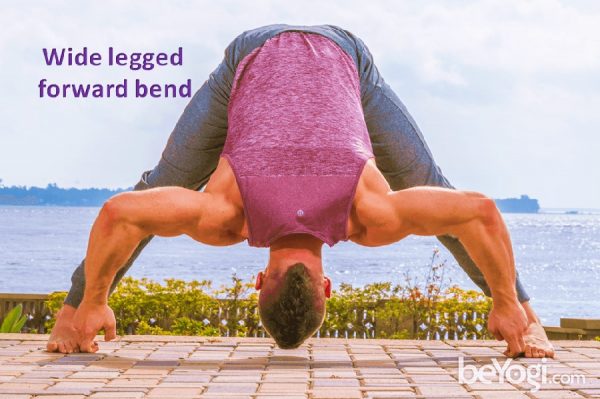
Wide legged forward bend
Wide legged forward bend is a beginner pose but provides many benefits for the body. To increase the flexibility of entire body, this pose helps as it stretches hamstrings, IT band, back muscles and groins. While bending it also helps on abdominal muscles to crunch and reduces belly fat too. Forward bending helps in the flow of fresh blood to head. This pose is recommended for those who suffer from depression, anxiety and mood swings. – Healthylife
LEVEL :Beginner
Anatomy :Hamstrings, Hips, Legs, Spine
Pose Type :Forward Bend, Hip Opener, Standing
Sanskrit :Prasarita Padottanasana, (pra-sa-REE-tah pah-doh-tahn-AHS-anna), prasarita = spread out, expanded, pada = foot, leg ,ut = intense tan = stretch
BENEFITS :Stretches the groins, hamstrings, and back muscles, Opens the hips, Brings fresh, oxygenated blood to the head, Relieves mild depression
CONTRAINDICATIONS
- Lower back pain
- Spine injury
HOW TO
- Stand in Tadasana (Mountain pose), facing the long edge of your mat.
- Step your feet wide apart, around 4-5 feet depending on your height. Make sure the inner arches of your feet are parallel. Firm the big toes and outer edges of your feet into the mat.
- Bring your hands to your hips. With an inhale, open your chest toward the sky to lengthen your torso.
- Exhale and fold forward at the hips, maintaining a straight back and open chest. Bring your hands to the floor beneath your shoulders, fingertips aligned with your toes.
- Inhale and engage the core to lengthen your torso. Exhale and fold deeper, reaching the crown of your head toward the mat while lifting your sitting bones toward the sky.
- If you feel comfortable here, broaden the shoulders, bend the elbows, and clasp your big toes with your index and middle fingers. Rest the crown of your head on the mat.
- Hold this pose for five breaths. On an inhalation, rise to standing and step the feet together. Return to Tadasana.
MODIFY OR REPLACE
Alternatives: Upavistha Konasana (Wide-Angle Seated Forward Bend)
Modifications:
- Place blocks on the floor to support your hands if you cannot reach the ground.
- Rest the crown of your head on a block or blanket.
- If your back is tight, focus on coming halfway down into the posture.
SEQUENCING TIPS
Before:
- Virabhadrasana II (Warrior II)
- Trikonasana (Triangle pose)
After:
- Sirsasana II (Tripod Headstand)
- Tarasana (Star pose)
TEACHING CUES
- Make sure your feet stay parallel to one another.
- If possible, release the crown of your head to the ground.
- Continue to lengthen the spine.
- Be careful to not lean forward. Keep your hips aligned over your ankles.
VARIATIONS
- Come into Sirsasana II (Tripod Headstand).
- Bring your hands into Reverse Prayer and hinge forward.
WATCH OUT FOR
- Hands not reaching the floor
- Excessive weight on the heels
- Locked knees
- Feet turning out, creating an external rotation in the legs
This article & image published here with prior permission from beyogi.com
Author: HealthyLife | Posted on: June 6, 2019
« For A Better Day Try Vinyasa Yoga Yoga changes gene expression for better »






















Write a comment